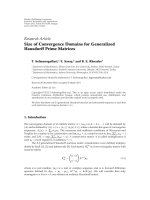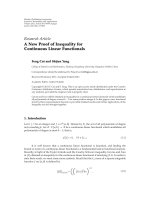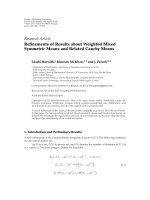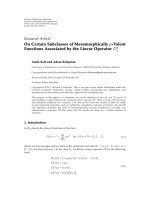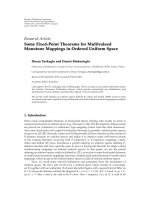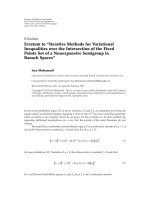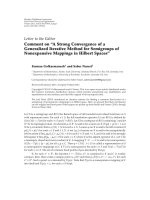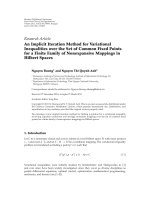Hindawi Publishing Corporation Fixed Point Theory and Applications Volume 2011, Article ID 186237, ppt
Bạn đang xem bản rút gọn của tài liệu. Xem và tải ngay bản đầy đủ của tài liệu tại đây (517.11 KB, 12 trang )
Hindawi Publishing Corporation
Fixed Point Theory and Applications
Volume 2011, Article ID 186237, 12 pages
doi:10.1155/2011/186237
Research Article
Some Fixed-Point Theorems for Multivalued
Monotone Mappings in Ordered Uniform Space
Duran Turkoglu and Demet Binbasioglu
Department of Mathematics, Faculty of Science, University of Gazi, Teknikokullar 06500, Ankara, Turkey
Correspondence should be addressed to Duran Turkoglu,
Received 22 September 2010; Accepted 8 March 2011
Academic Editor: Jong Kim
Copyright q 2011 D. Turkoglu and D. Binbasioglu. This is an open access article distributed under
the Creative Commons Attribution License, which permits unrestricted use, distribution, and
reproduction in any medium, provided the original work is properly cited.
We use the order relation on uniform spaces defined by Altun and Imdad 2009 to prove some
new fixed-point and coupled fixed-point theorems for multivalued monotone mappings in ordered
uniform spaces.
1. Introduction
There exists considerable literature of fixed-point theory dealing with results on fixed or
common fixed-points in uniform space e.g., between 1–14. But the majority of these results
are proved for contractive or contractive type mapping notice from the cited references.
Also some fixed-point and coupled fixed-point theorems in partially ordered metric spaces
are given in 15–20. Recently, Aamri and El Moutawakil 2 have introduced the concept of
E-distance function on uniform spaces and utilize it to improve some well-known results
of the existing literature involving both E-contractive or E-expansive mappings. Lately,
Altun and Imdad 21 have introduced a partial ordering on uniform spaces utilizing E-
distance function and have used the same to prove a fixed-point theorem for single-valued
nondecreasing mappings on ordered uniform spaces. In this paper, we use the partial
ordering on uniform spaces which is defined by 21, so we prove some fixed-point theorems
of multivalued monotone mappings and some coupled fixed-point theorems of multivalued
mappings which are given for ordered metric spaces in 22 on ordered uniform spaces.
Now, we recall some relevant definitions and properties from the foundation of
uniform spaces. We call a pair X, ϑ to be a uniform space which consists of a nonempty
set X together with an uniformity ϑ wherein the latter begins with a special kind of filter on
X × X whose all elements contain the diagonal Δ{x, x : x ∈ X}.IfV ∈ ϑ and x, y ∈ V ,
y, x ∈ V then x and y are said to be V -close. Also a sequence {
x
n
} in X,issaidtobe
2 Fixed Point Theory and Applications
a Cauchy sequence with regard to uniformity ϑ if for any V ∈ ϑ, there exists N ≥ 1 such that
x
n
and x
m
are V -close for m, n ≥ N. An uniformity ϑ defines a unique topology τϑ on X
for which the neighborhoods of x ∈ X are the sets V x{y ∈ X : x, y ∈ V } when V runs
over ϑ.
A uniform space X, ϑ is said to be Hausdorff if and only if the intersection of all
the V ∈ ϑ reduces to diagonal Δ of X,thatis,x, y ∈ V for V ∈ ϑ implies x y.Notice
that Hausdorffness of the topology induced by the uniformity guarantees the uniqueness of
limit of a sequence in uniform spaces. An element of uniformity ϑ is said to be symmetrical
if V V
−1
{y, x : x, y ∈ V }. Since each V ∈ ϑ contains a symmetrical W ∈ ϑ and if
x, y ∈ W then x and y are both W and V -close and then one may assume that each V ∈ ϑ
is symmetrical. When topological concepts are mentioned in the context of a uniform space
X, ϑ, they are naturally interpreted with respect to the topological space X, τϑ.
2. Preliminaries
We will require the following definitions and lemmas in the sequel.
Definition 2.1 see 2.LetX, ϑ be a uniform space. A function p : X × X → R
is said to
be an E-distance if
p
1
for any V ∈ ϑ, there exists δ>0, such that pz, x ≤ δ and pz, y ≤ δ for some
z ∈ X imply x, y ∈ V ,
p
2
px, y ≤ px, zpz, y, for all x, y, z ∈ X.
The following lemma embodies some useful properties of E-distance.
Lemma 2.2 see 1, 2. Let X, ϑ be a Hausdorff uniform space and p be an E-distance on X.Let
{x
n
} and {y
n
} be arbitrary sequences in X and {α
n
}, {β
n
} be sequences in R
converging to 0. Then,
for x, y, z ∈ X, the following holds:
a if px
n
,y ≤ α
n
and px
n
,z ≤ β
n
for all n ∈ N,theny z. In particular, if px, y0
and px, z0,theny z,
b if px
n
,y
n
≤ α
n
and px
n
,z ≤ β
n
for all n ∈ N,then{y
n
} converges to z,
c if px
n
,x
m
≤ α
n
for all m>n,then{x
n
} is a Cauchy sequence in X, ϑ.
Let X, ϑ be a uniform space equipped with E-distance p. A sequence in X is p-Cauchy if it
satisfies the usual metric condition. There are several concepts of completeness in this setting.
Definition 2.3 see 1, 2.LetX, ϑ be a uniform space and p be an E-distance on X. Then
i X said to be S-complete if for every p-Cauchy sequence {x
n
} there exists x ∈ X with
lim
n →∞
px
n
,x0,
ii X is said to be p-Cauchy complete if for every p-Cauchy sequence {x
n
} there exists
x ∈ X with lim
n →∞
x
n
x with respect to τϑ,
iii f : X → X is p-continuous if lim
n →∞
px
n
,x0 implies
lim
n →∞
p
fx
n
,fx
0,
2.1
Fixed Point Theory and Applications 3
iv f : X → X is τϑ-continuous if lim
n →∞
x
n
x with respect to τϑ implies
lim
n →∞
fx
n
fx with respect to τϑ.
Remark 2.4 see 2.LetX, ϑ be a Hausdorff uniform space and let {x
n
} be a p-Cauchy
sequence. Suppose that X is S-complete, then there exists x ∈ X such that lim
n →∞
px
n
,x0.
Then Lemma 2.2b gives that lim
n →∞
x
n
x with respect to the topology τϑ which shows
that S-completeness implies p-Cauchy completeness.
Lemma 2.5 see 15. Let X, ϑ be a Hausdorff uniform space, p be E-distance on X and ϕ : X →
R. Define the relation “”onX as follows:
x y ⇐⇒ x y or p
x, y
≤ ϕ
x
− ϕ
y
. 2.2
Then “” is a (partial) order on X induced by ϕ.
3. The Fixed-Point Theorems of Multivalued Mappings
Theorem 3.1. Let X, ϑ a Hausdorff uniform space and p is an E-distance on X, ϕ : X → R
be a function which is bounded below and “” the order introduced by ϕ.LetX be also a p-Cauchy
complete space, T : X → 2
X
be a multivalued mapping, x, ∞{y ∈ X : x y} and M {x ∈
X | Tx ∩ x, ∞
/
∅}. Suppose that:
i T is upper semicontinuous, that is, x
n
∈ X and y
n
∈ Tx
n
with x
n
→ x
0
and y
n
→ y
0
,
implies y
0
∈ Tx
0
,
ii M
/
∅,
iii for each x ∈ M, Tx ∩ M ∩ x, ∞
/
∅.
Then T has a fixed-point x
∗
and there exists a sequence {x
n
} with
x
n−1
x
n
∈ T
x
n−1
,n 1, 2, 3, 3.1
such that x
n
→ x
∗
. Moreover if ϕ is lower semicontinuous, then x
n
x
∗
for all n.
Proof. By the condition ii, take x
0
∈ M.Fromiii, there exist x
1
∈ Tx
0
∩ M and x
0
x
1
.
Again from iii, there exist x
2
∈ Tx
1
∩ M.Thusx
1
x
2
.
Continuing this procedure we get a sequence {x
n
} satisfying
x
n−1
x
n
∈ T
x
n−1
,n 1, 2, 3, 3.2
So by the definition of “”, we have ···ϕx
2
≤ ϕx
1
≤ ϕx
0
, that is, the sequence {ϕx
n
}
is a nonincreasing sequence in R. Since ϕ is bounded from below, {ϕx
n
} is convergent and
4 Fixed Point Theory and Applications
hence it is C auchy, that is, for all ε>0, there exists n
0
∈ N such that for all m>n>n
0
we have
|ϕx
m
− ϕx
n
| <ε. Since x
n
x
m
, we have x
n
x
m
or px
n
,x
m
≤ ϕx
n
− ϕx
m
. Therefore,
p
x
n
,x
m
≤ ϕ
x
n
− ϕ
x
m
ϕ
x
n
− ϕ
x
m
<ε,
3.3
which shows that in view of Lemma 2.2c that {x
n
} is p-Cauchy sequence. By the p-Cauchy
completeness of X, {x
n
} converges to x
∗
. Since T is upper semicontinuous, x
∗
∈ Tx
∗
.
Moreover, when ϕ is lower semicontinuous, for each n
p
x
n
,x
∗
lim
m →∞
p
x
n
,x
m
≤ lim
m →∞
sup
ϕ
x
n
− ϕ
x
m
ϕ
x
n
− lim
m →∞
inf ϕ
x
m
≤ ϕ
x
n
− ϕ
x
∗
.
3.4
So x
n
x
∗
, for all n.
Similarly, we can prove the following.
Theorem 3.2. Let X, ϑ a Hausdorff uniform space and p an E-distance on X, ϕ : X → R be
a function which is bounded above and “” the order introduced by ϕ.LetX be also a p-Cauchy
complete space, T : X → 2
X
be a multivalued mapping, −∞,x{y ∈ X : y x} and M {x ∈
X | Tx ∩ −∞,x
/
∅}. Suppose that
i T is upper semicontinuous, that is, x
n
∈ X and y
n
∈ Tx
n
with x
n
→ x
0
and y
n
→ y
0
,
implies y
0
∈ Tx
0
,
ii M
/
∅,
iii for each x ∈ M, Tx ∩ M ∩ −∞,x
/
∅.
Then T has a fixed-point x
∗
and there exists a sequence {x
n
} with
x
n−1
x
n
∈ T
x
n−1
,n 1, 2, 3, 3.5
such that x
n
→ x
∗
. Moreover, if ϕ is upper semicontinuous, then x
∗
x
n
for all n.
Corollary 3.3. Let X, ϑ a Hausdorff uniform space and p is an E-distance on X, ϕ : X → R
be a function which is bounded below and “” the order introduced by ϕ.LetX be also a p-Cauchy
complete space, T : X → 2
X
be a multivalued mapping and x, ∞{y ∈ X : x y}. Suppose
that:
i T is upper semicontinuous, that is, x
n
∈ X and y
n
∈ Tx
n
with x
n
→ x
0
and y
n
→ y
0
,
implies y
0
∈ Tx
0
,
Fixed Point Theory and Applications 5
ii T satisfies the monotonic condition: for any x,y ∈ X with x y and any u ∈ Tx,there
exists v ∈ Ty such that u v,
iii there exists an x
0
∈ X such that Tx
0
∩ x
0
, ∞
/
∅.
Then T has a fixed-point x
∗
and there exists a sequence {x
n
} with
x
n−1
x
n
∈ T
x
n−1
,n 1, 2, 3, , 3.6
such that x
n
→ x
∗
. Moreover if ϕ is lower semicontinuous, then x
n
x
∗
for all n.
Proof. By iii, x
0
∈ M {x ∈ X : Tx ∩ x, ∞
/
∅}. For x ∈ M, take y ∈ Tx and
x y. By the monotonicity of T, there exists z ∈ Ty such that y z.Soy ∈ M,and
Tx ∩ M ∩ x, ∞
/
∅. The conclusion follows from Theorem 3.1.
Corollary 3.4. Let X, ϑ a Hausdorff uniform space and p is an E-distance on X, ϕ : X → R
be a function which is bounded above and “” the order introduced by ϕ.LetX be also a p-Cauchy
complete space, T : X → 2
X
be a multivalued mapping and −∞,x{y ∈ X : y x}. Suppose
that:
i T is upper semicontinuous,
ii T satisfies the monotonic c ondition; for any x, y ∈ X with x y and any v ∈ Ty,there
exists u ∈ Tx such that u v,
iii there exists an x
0
∈ X such that Tx
0
∩ −∞,x
0
/
∅.
Then T has a fixed-point x
∗
and there exists a sequence {x
n
} with
x
n−1
x
n
∈ T
x
n−1
,n 1, 2, , 3.7
such that x
n
→ x
∗
. Moreover if ϕ is upper semicontinuous, then x
n
x
∗
for all n.
Corollary 3.5. Let X, ϑ a Hausdorff uniform space and p is an E-distance on X, ϕ : X → R
be a function which is bounded below and “” the order introduced by ϕ.LetX be also a p-Cauchy
complete space, f : X → X be a map and M {x ∈ X : x fx}. Suppose that:
i f is τϑ-continuous,
ii M
/
∅,
iii for each x ∈ M, fx ∈ M.
Then f has a fixed-point x
∗
and the sequence
x
n−1
x
n
f
x
n−1
,n 1, 2, 3, 3.8
converges to x
∗
. Moreover if ϕ is lower semicontinuous, then x
n
x
∗
for all n.
Corollary 3.6. Let X, ϑ be a Hausdorff uniform space, p is an E-distance on X, ϕ : X → R be
a function which is bounded above, and “” the order introduced by ϕ.LetX be also a p-Cauchy
6 Fixed Point Theory and Applications
complete space, f : X → X be a map and M {x ∈ X : x fx}. Suppose that:
i f is τϑ-continuous,
ii M
/
∅,
iii for each x ∈ M, fx ∈ M.
Then f has a fixed-point x
∗
. And the sequence
x
n−1
x
n
f
x
n−1
,n 1, 2, 3, 3.9
converges to x
∗
. Moreover, if ϕ is upper semicontinuous, then x
n
x
∗
for all n.
Corollary 3.7. Let X, ϑ be a Hausdorff uniform space, p is an E-distance on X, ϕ : X → R be
a function which is bounded below, and “” the order introduced by ϕ.LetX be also a p-Cauchy
complete space, f : X → X be a map and M {x ∈ X : x fx}. Suppose that:
i f is τϑ-continuous,
ii f is monotone increasing, that is, for x y we have fx fy,
iii there exists an x
0
,withx
0
fx
0
.
Then f has a fixed-point x
∗
and the sequence
x
n−1
x
n
f
x
n−1
,n 1, 2, 3, 3.10
converges to x
∗
. Moreover if ϕ is lower semicontinuous, then x
n
x
∗
for all n.
Example 3.8. Let X {k, l, m} and ϑ {V ⊂ X × X : Δ ⊂ V }. Define p : X × X → R
as
px, x0 for all x ∈ X, pk,lpl, k2, pk, mpm, k1vepl, mpm, l3.
Since definition of ϑ,
V ∈ϑ
V Δand this show that the uniform space X, ϑ is a Hausdorff
uniform space. On the other hand, pk, l ≤ pk, mpm, l, pk, m ≤ pk,lpl, m and
pl, m ≤ pl, kpk, m for k, l, m ∈ X and thus p is an E-distanceasitisametricon
X. Next define ϕ : X → R ϕk3, ϕl2, ϕm1. Since pk,mpm, k1 ≤
ϕk − ϕm, therefore
k m. But as pl, kpk, l2 |ϕk − ϕl| therefore k
✓
l and
l
✓
k. Again similarly l
✓
m and m
✓
l which show that this ordering is partial and hence X is a
partially ordered uniform space. Define f : X → X as fkk, fll and fmm, then
by a routine calculation one can verify that all the conditions of Corollary 3.7 are satisfied
and f has a fixed-point. Notice that pfk,fl pk, l which shows that f is neither E-
contractive nor E expansive, therefore the results of
2 are not applicable in the context of
this example. Thus, this example demonstrates the utility of our result.
Corollary 3.9. Let X, ϑ be a Hausdorff uniform space, p is an E-distance on X, ϕ : X → R be a
function which is bounded above and “” the order introduced by ϕ.LetX be also a p-Cauchy complete
space and f : X → X be a map. Suppose that
i f is τϑ-continuous,
ii f is monotone increasing, that is, for x y we have fx fy,
iii there exists an x
0
with x
0
fx
0
.
Fixed Point Theory and Applications 7
Then f has a fixed-point x
∗
. And the sequence
x
n−1
x
n
f
x
n−1
,n 1, 2, 3, 3.11
converges to x
∗
. Moreover if ϕ is upper semicontinuous, then x
n
x
∗
for all n.
Theorem 3.10. Let X, ϑ be a Hausdorff uniform space, p is an E-distance on X, ϕ : X → R be
a continuous function bounded below and “” the order introduced by ϕ.LetX be also a p-Cauchy
complete space, T : X → 2
X
be a multivalued mapping and x, ∞{y ∈ X : x y}. Suppose
that
i T satisfies the monotonic condition: for each x y and each u ∈ Tx there exists v ∈ Ty
such that u v,
ii Tx is compact for each x ∈ X,
iii M {x ∈ X : Tx ∩ x, ∞
/
∅}
/
∅.
Then T has a fixed-point x
0
.
Proof. We will prove that M has a maximum element. Let {x
v
}
v∈Λ
be a totally ordered subset
in M, where Λ is a directed set. For v,μ ∈ Λ and v ≤ μ, one has x
v
x
μ
, which implies
that ϕx
v
≥ ϕx
μ
for v ≤ μ. Since ϕ is bounded below, {ϕx
v
} is a convergence net in R.
From px
v
,x
μ
≤ ϕx
v
− ϕx
μ
,wegetthat{x
v
} is a p-cauchy net in X.Bythep-Cauchy
completeness of X,letx
v
converge to z in X.
For given μ ∈ Λ
px
μ
,zlim
v
px
μ
,x
v
≤ lim
v
ϕx
μ
− ϕx
v
ϕx
μ
− ϕx
z
.Sox
μ
z for all μ ∈ Λ.
For μ ∈ Λ, by the condition i, for each u
μ
∈ Tx
μ
, there exists a v
μ
∈ Tz such that
u
μ
v
μ
. By the compactness of Tz, there exists a convergence subnet {v
μ
|
} of {v
μ
}. Suppose
that {v
μ
|
} converges to w ∈ Tz. Take Λ
|
such that μ
|
≥ Λ
|
implies u
μ
v
μ
v
μ
|
.
We have
p
u
μ
,w
lim
μ
|
p
u
μ
,v
μ
|
≤ lim
μ
|
ϕ
u
μ
− ϕ
v
μ
|
ϕ
u
μ
− ϕ
w
. 3.12
So u
μ
w for all μ and
p
z, w
lim
μ
p
u
μ
,w
≤ lim
μ
ϕ
u
μ
− ϕ
w
ϕ
z
− ϕ
w
.
3.13
So z w and this gives that z ∈ M. Hence we have proven that {x
μ
} has an upper
bound in M.
By Zorn’s Lemma, there exists a maximum element x
0
in M. By the definition of M,
there exists a y
0
∈ Tx
0
such that x
0
y
0
. By the condition i, there exists a z
0
∈ Ty
0
such
that y
0
z
0
. Hence y
0
∈ M. Since x
0
is the maximum element in M, it follows that y
0
x
0
and x
0
∈ Tx
0
.Sox
0
is a fixed-point of T.
Theorem 3.11. Let X, ϑ be a Hausdorff uniform space, p is an E-distance on X, ϕ : X → R be
a continuous function bounded above and “” the order introduced by ϕ.LetX be also a p-Cauchy
complete space, T : X → 2
X
be a multivalued mapping and −∞,x{y ∈ X : y x}. Suppose
8 Fixed Point Theory and Applications
that
i T satisfies the following condition; for each x y and v ∈ Tx,thereexistsu ∈ Ty such
that u v,
ii Tx is compact for each x ∈ X,
iii M {x ∈ X : Tx ∩ −∞,x
/
∅}
/
∅.
Then T has a fixed-point.
Corollary 3.12. Let X, ϑ be a Hausdorff uniform space, p is an E-distance on X, ϕ : X → R be
a continuous function bounded below and “” the order introduced by ϕ.LetX be also a p-Cauchy
complete space and
f : X → X be a map. Suppose that;
i f is monotone increasing, that is for x y, fx fy,
ii there is an x
0
∈ X such that x
0
fx
0
.
Then f has a fixed-point.
Corollary 3.13. Let X, ϑ be a Hausdorff uniform space, p is an E-distance on X, ϕ : X → R be
a continuous function bounded above and “” the order introduced by ϕ.LetX be also a p-Cauchy
complete space and f : X → X be a map. Suppose that;
i f is monotone increasing, that is, for x y, fx fy;
ii there is an x
0
∈ X such that x
0
fx
0
.
Then f has a fixed-point.
4. The Coupled Fixed-Point Theorems of Multivalued Mappings
Definition 4.1. An element x, y ∈ X × X is called a coupled fixed-point of the multivalued
mapping T : X × X → 2
X
if x ∈ Tx, y, y ∈ Ty, x.
Theorem 4.2. Let X, ϑ be a Hausdorff uniform space, p is an E-distance on X, ϕ : X → R be
a function bounded below and “” be the order in X introduced by ϕ.LetX be also a p-Cauchy
complete space, T : X × X → 2
X
be a multivalued mapping, x, ∞{y ∈ X : x y},
−∞,y{x ∈ X : x y}, and M {x, y ∈ X × X : x y, Tx, y ∩ x, ∞
/
∅ and
Ty, x ∩ −∞,y
/
∅}. Suppose that:
i T is upper semicontinuous, that is, x
n
∈ X, y
n
∈ X and z
n
∈ Tx
n
,y
n
,withx
n
→ x
0
,
y
n
→ y
0
and z
n
→ z
0
implies z
0
∈ Tx
0
,y
0
,
ii M
/
∅,
iii for each x, y ∈ M,thereisu, v ∈ M such that u ∈ Tx, y ∩ x, ∞ and v ∈
Ty, x ∩ −∞,y.
Then T has a coupled fixed-point x
∗
,y
∗
, that is, x
∗
∈ Tx
∗
,y
∗
and y
∗
∈ Ty
∗
,x
∗
.And
there exist two sequences {x
n
} and {y
n
} with
x
n−1
x
n
∈ T
x
n−1
,y
n−1
,y
n−1
y
n
∈ T
y
n−1
,x
n−1
,n 1, 2, 3, 4.1
such that x
n
→ x
∗
and y
n
→ y
∗
.
Fixed Point Theory and Applications 9
Proof. By the condition ii, take x
0
,y
0
∈ M.Fromiii, there exist x
1
,y
1
∈ M such that
x
1
∈ Tx
0
,y
0
, x
0
x
1
and y
1
∈ Ty
0
,x
0
, y
1
y
0
. Again from iii, there exist x
2
,y
2
∈ M
such that x
2
∈ Tx
1
,y
1
, x
1
x
2
and y
2
∈ Ty
1
,x
1
, y
2
y
1
.
Continuing this procedure we get two sequences {x
n
} and {y
n
} satisfying x
n
,y
n
∈ M
and
x
n−1
x
n
∈ T
x
n−1
,y
n−1
,n 1, 2, ,
y
n−1
y
n
∈ T
y
n−1
,x
n−1
,n 1, 2,
4.2
So
x
0
x
1
··· x
n
··· y
n
··· y
2
y
1
. 4.3
Hence,
ϕ
x
0
≥ ϕ
x
1
≥···≥ ϕ
x
n
≥···≥ ϕ
y
n
≥···≥ ϕ
y
1
≥ ϕ
y
0
. 4.4
From this we get that ϕx
n
and ϕy
n
are convergent sequences. By the definition of “”asin
the proof of Theorem 3.1, it is easy to prove that {x
n
} and {y
n
} are p-Cauchy sequences. Since
X is p-Cauchy complete, let {x
n
} converge to x
∗
and {y
n
} converge to y
∗
. Since T is upper
semicontinuous, x
∗
∈ Tx
∗
,y
∗
and y
∗
∈ Ty
∗
,x
∗
. Hence x
∗
,y
∗
is a coupled fixed-point of
T.
Corollary 4.3. Let X, ϑ be a Hausdorff uniform space, p is an E-distance on X, ϕ : X → R be
a function bounded below, and “” be the order in X introduced by ϕ.LetX be also a p-Cauchy
complete space, f : X × X → X be a mapping and M {x, y ∈ X × X : x y and x fx, y
and fx, y y}. Suppose that;
i f is τϑ-continuous,
ii M
/
∅,
iii for each x, y ∈ M, x f
x, y and fy,x y.
Then f has a coupled fixed-point x
∗
,y
∗
, that is, x
∗
fx
∗
,y
∗
and y
∗
fy
∗
,x
∗
.And
there exist two sequences {x
n
} and {y
n
} with x
n−1
x
n
fx
n−1
,y
n−1
, y
n−1
y
n
fy
n−1
,x
n−1
,
n 1, 2, such that x
n
→ x
∗
and y
n
→ y
∗
.
Corollary 4.4. Let X, ϑ be a Hausdorff uniform space, p is an E-distance on X,ϕ : X → R be
a function bounded below, and “” be the order in X introduced by ϕ.LetX be also a p-Cauchy
complete space, f : X × X → X be a mapping and M {x, y ∈ X × X : x y and x fx, y
and fx, y y}. Suppose that;
i f is τϑ-continuous,
ii M
/
∅,
iii f is mixed monotone, that is for each x
1
x
2
and y
1
y
2
, fx
1
,y
1
fx
2
,y
2
.
Then f has a coupled fixed-point x
∗
,y
∗
. And there exist two sequences {x
n
} and {y
n
} with
x
n−1
x
n
fx
n−1
,y
n−1
, y
n−1
y
n
fy
n−1
,x
n−1
, n 1, 2, such that x
n
→ x
∗
and
y
n
→ y
∗
.
10 Fixed Point Theory and Applications
Theorem 4.5. Let X, ϑ be a Hausdorff uniform space, p is an E-distance on X, ϕ : X → R
be a continuous function, and “” be the order in X introduced by ϕ.LetX be also a p-Cauchy
complete space, T : X × X → 2
X
be a multivalued mapping, x, ∞{y ∈ X : x y},
−∞,y{x ∈ X : x y}, and M {x, y ∈ X × X : x y, Tx, y ∩ x, ∞
/
∅ and
Ty, x ∩ −∞,y
/
∅}. Suppose that;
i T is mixed monotone, that is, for x
1
y
1
, x
2
y
2
and u ∈ Tx
1
,y
1
, v ∈ Ty
1
,x
1
,there
exist w ∈ Tx
2
,y
2
, z ∈ Ty
2
,x
2
such that u w, v z,
ii M
/
∅,
iii Tx, y is compact for each x, y ∈ X × X.
Then T has a coupled fixed-point.
Proof. By ii, there exists x
0
,y
0
∈ M with x
0
y
0
, Tx
0
,y
0
∩ x
0
, ∞
/
∅ and Ty
0
,x
0
∩
−∞,y
0
/
∅.LetC {x, y : x
0
x, y y
0
, Tx, y ∩ x, ∞
/
∅ and Ty, x ∩ −∞,y
/
∅}.
Then x
0
,y
0
∈ C. Define the order relation “”inC by
x
1
,y
1
x
2
,y
2
⇐⇒ x
1
x
2
,y
2
y
1
. 4.5
It is easy to prove that C, becomes an ordered space.
We will prove that C has a maximum element. Let {x
v
,y
v
}
v∈Λ
be a totally ordered
subset in C, where Λ is a directed set. For v, μ ∈ Λ and v ≤ μ, one has x
v
,y
v
x
μ
,y
μ
.So
x
v
x
μ
and y
μ
y
v
, which implies that
ϕ
x
0
≥ ϕ
x
v
≥ ϕ
x
μ
≥ ϕ
y
0
,
ϕ
y
0
≤ ϕ
y
μ
≤ ϕ
y
v
≤ ϕ
x
0
4.6
for v ≤ μ.
Since {ϕx
v
} and {ϕy
v
} are convergence nets in R.From
p
x
v
,x
μ
≤ ϕ
x
v
− ϕ
x
μ
,p
y
μ
,y
v
≤ ϕ
y
μ
− ϕ
y
v
, 4.7
we get that {x
v
} and {y
v
} are p-Cauchy nets in X.Bythep-Cauchy completeness of X,letx
v
convergence to x
∗
and y
v
convergence to y
∗
in X. For given μ ∈ Λ,
p
x
μ
,x
∗
lim
v
p
x
μ
,x
v
≤ lim
v
ϕ
x
μ
− ϕ
x
v
ϕ
x
μ
− ϕ
x
∗
,
p
y
μ
,y
∗
lim
v
p
y
μ
,y
v
≤ lim
v
ϕ
y
v
− ϕ
y
μ
ϕ
y
v
− ϕ
y
∗
.
4.8
So x
0
x
μ
x
∗
and y
μ
y
∗
y
0
for all μ ∈ Λ.
For μ ∈ Λ, by the condition i, for each u
μ
∈ Tx
μ
,y
μ
with x
μ
u
μ
and v
μ
∈ Ty
μ
,x
μ
with v
μ
y
μ
, t here exist w
μ
∈ Tx
∗
,y
∗
and z
μ
∈ Ty
∗
,x
∗
such that u
μ
w
μ
and v
μ
z
μ
.
By the compactness of Tx
∗
,y
∗
and Ty
∗
,x
∗
, there exist convergence subnets {w
μ
|
} of {w
μ
}
Fixed Point Theory and Applications 11
and {z
μ
|
} of {z
μ
}. Suppose that {w
μ
|
} converges to w ∈ Tx
∗
,y
∗
and {z
μ
|
} converges to
z ∈ Ty
∗
,x
∗
. Take Λ
|
, such that μ
|
≥ Λ
|
implies u
μ
v
μ
v
μ
|
. We have
p
u
μ
,w
lim
μ
|
p
u
μ
,u
μ
|
≤ lim
μ
|
ϕ
u
μ
− ϕ
u
μ
|
ϕ
u
μ
− ϕ
w
,
p
z, v
μ
lim
μ
|
p
v
μ
|
,v
μ
≤ lim
μ
|
ϕ
v
μ
|
− ϕ
v
μ
ϕ
z
− ϕ
v
μ
.
4.9
So x
μ
u
μ
w and z v
μ
y
μ
for all μ. And
p
x
∗
,w
lim
μ
|
p
x
μ
|
,u
μ
|
≤ lim
μ
|
ϕ
x
μ
|
− ϕ
u
μ
|
ϕ
x
∗
− ϕ
w
,
p
z, y
∗
lim
μ
|
p
v
μ
|
,y
μ
|
≤ lim
μ
|
ϕ
v
μ
|
− ϕ
y
μ
|
ϕ
z
− ϕ
y
∗
.
4.10
So x
∗
w and z y
∗
, this gives that x
∗
,y
∗
∈ C. Hence we have proven that {x
μ
,y
μ
}
μ∈Λ
has
an upper bound in C.
By Zorn’s lemma, there exists a maximum element
x, y in C. By the definition of C,
there exist
u ∈ T x, y, v ∈ Ty, x, such that x
0
u, v y
0
and x u, v y.Bythe
condition i there exist
w ∈ Tu, v,
−
z
∈ T
v, u such that x
0
u w and z v y
0
.
Hence
u, v ∈ C and x, y u, v. Since x, y is maximum element in C, it follows that
x, yu, v, and it follows that x u ∈ Tx, u and y v ∈ Ty,x.Sox, y is a coupled
fixed-point of T.
Corollary 4.6. Let X, ϑ be a Hausdorff uniform space, p is an E-distance on X, ϕ : X → R be a
continuous function, and “” be the order in X introduced by ϕ.LetX be also a p-Cauchy complete
space and f : X × X → X be a mapping. Suppose that;
i f is mixed monotone, that is for x
1
y
1
, x
2
y
2
and fx
1
,y
1
fy
2
,x
2
,
ii there exist x
0
,y
0
∈ X such that x
0
fx
0
,y
0
and fy
0
,x
0
y
0
.
Then f has a coupled fixed-point.
References
1 M. Aamri, S. Bennani, and D. El Moutawakil, “Fixed points and variational principle in uniform
spaces,” Siberian Electronic Mathematical Reports, vol. 3, pp. 137–142, 2006.
2 M. Aamri and D. El Moutawakil, “Common fixed point theorems for E-contractive or E-expansive
maps in uniform spaces,” Acta Mathematica Academiae Peadegogicae Nyiregy-Haziensis, vol. 20, no. 1,
pp. 83–91, 2004.
3 M. Aamri and D. El Moutawakil, “Weak compatibility and common fixed point theorems for A-
contractive and E-expansive maps in uniform spaces,” Serdica Mathematical Journal,vol.31,no.1-2,
pp. 75–86, 2005.
4 S. P. Acharya, “Some results on fixed points in uniform spaces,” Yokohama Mathematical Journal, vol.
22, pp. 105–116, 1974.
5 R. P. Agarwal, D. O’Regan, and N. S. Papageorgiou, “Common fixed point theory for multivalued
contractive maps of Reich type in uniform spaces,” Applicable Analysis, vol. 83, no. 1, pp. 37–47, 2004.
6 M. O. Olatinwo, “Some common fixed point theorems for selfmappings in uniform space,” Acta
Mathematica Academiae Peadegogicae Nyiregyhaziensis, vol. 23, no. 1, pp. 47–54, 2007.
12 Fixed Point Theory and Applications
7 M. O. Olatinwo, “Some existence and uniqueness common fixed point theorems for selfmappings in
uniform space,” Fasciculi Mathematici, vol. 38, pp. 87–95, 2007.
8 M. O. Olatinwo, “On some common fixed point theorems of Aamri and El Moutawakil in uniform
spaces,” Applied Mathematics E-Notes, vol. 8, pp. 254–262, 2008.
9 D. O’Regan, R. P. Agarwal, and D. Jiang, “Fixed point and homotopy results in uniform spaces,”
Bulletin of the Belgian Mathematical Society. Simon Stevin, vol. 11, no. 2, pp. 289–296, 2004.
10 D. T
¨
urkoglu, “Fixed point theorems on uniform spaces,” Indian Journal of Pure and Applied Mathematics,
vol. 34, no. 3, pp. 453–459, 2003.
11 D. Turkoglu, “Some fixed point theorems for hybrid contractions in uniform space,” Taiwanese Journal
of Mathematics, vol. 12, no. 3, pp. 807–820, 2008.
12 D. Turkoglu, “Some common fixed point theorems for weakly compatible mappings in uniform
spaces,” Acta Mathematica Hungarica, vol. 128, no. 1-2, pp. 165–174, 2010.
13 D. T
¨
urkoglu and B. Fisher, “Fixed point of multivalued mapping in uniform spaces,” Indian Academy
of Sciences, vol. 113, no. 2, pp. 183–187, 2003.
14 D. T
¨
urko
˘
glu and B. E. Rhoades, “A general fixed point theorem for multi-valued mapping in uniform
space,” The Rocky Mountain Journal of Mathematics, vol. 38, no. 2, pp. 639–647, 2008.
15 R. P. Agarwal, M. A. El-Gebeily, and D. O’Regan, “Generalized contractions in partially ordered
metric spaces,” Applicable Analysis, vol. 87, no. 1, pp. 109–116, 2008.
16 T. G. Bhaskar and V. Lakshmikantham, “Fixed point theorems in partially ordered metric spaces and
applications,” Nonlinear Analysis: Theory, Methods & Applications, vol. 65, no. 7, pp. 1379–1393, 2006.
17 D. J. Guo and V. Lakshmikantham, “Coupled fixed points of nonlinear operators with applications,”
Nonlinear Analysis: Theory, Methods & Applications, vol. 11, no. 5, pp. 623–632, 1987.
18 V. Lakshmikantham and L. B. Ciric, “Coupled fixed point theorems for nonlinear contractions in
partially ordered metric spaces,” Nonlinear Analysis: Theory, Methods & Applications, vol. 70, no. 12, pp.
4341–4349, 2009.
19 J. J. Nieto and R. R. Lopez, “Contractive mapping theorems in partially ordered sets and applications
to ordinary differential equations,” Order, vol. 22, no. 3, pp. 223–239, 2005.
20 B. Samet, “Coupled fixed point theorems for a generalized Meir-Keeler contraction in partially
ordered metric spaces,” Nonlinear Analysis: Theory, Methods & Applications, vol. 72, no. 12, pp. 4508–
4517, 2010.
21 I. Altun and M. Imdad, “Some fixed point theorems on ordered uniform spaces,” Filomat, vol. 23, no.
3, pp. 15–22, 2009.
22 X. Zhang, “Fixed point theorems of multivalued monotone mappings in ordered metric spaces,”
Applied Mathematics Letters, vol. 23, no. 3, pp. 235–240, 2010.
